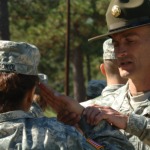One of the basic premises of Community Emergency Response Team (CERT) Training is to develop leadership.
In an emergency, the first qualified person on the scene takes the reins of leadership as the “Incident Commander,” following the CERT guidelines . . . but then turns over that leadership to a more qualified member of the team who may join the action later.
This is one of the reasons you want as many of your people fully-trained as possible. It’s not unlike the cross-training that members of the military special forces receive.

Military training equals leadership for CERT.
(In fact, some of the best people to get involved in a company or neighborhood CERT are former military or people with actual first responder experience.)
Wanted: Self-Starters
But that special experience aside, the best leaders are going to be those people who have the vision, foresight and commitment to play a key role in forming a team. These are the natural leaders in your business or community who are self-starters. You will find them heading up the team sports programs like Little League Baseball or Soccer programs. In business they are the people who take on additional tasks or make suggestions to improve products, etc.
Remember, this is a “voluntary” program.
You don’t want to “assign” people to positions on the team. That can open you up to possible legal problems and could jeopardize the spirit (if not the letter) of the Good Samaritan legal protection for individuals.
In building an Emergency Plan, you define the roles to be played and the suggested activities within them and give team members the opportunity to step forward and do what they are comfortable with.
Suggested Team Positions
As you build an Emergency Response Plan, here are some suggested team positions and qualifications:
1. Incident Commander – Most qualified volunteer with additional training in the Incident Command System (ICS) and the National Incident Management System (NIMS). You ideally want to have at least 3 or 4 members of your team qualified to fill this position.
2. Search & Rescue Team Leader – CERT qualified plus previous first responder experience or training if possible.
3. Triage & First Aid Team Leader – CERT qualified plus training in Red Cross First Aid and related courses. Retired or former nurses, teachers, military with medic training, etc. are also desirable if they are available to you.
4. Logistics Team Leader – Someone who keeps track of various tools and other assets that are available in the neighborhood . . . or, in the case of a business or enterprise, on location. This could include fire suppression equipment, tools, generators, etc.
5. Division Leaders – Depending on the size of your neighborhood or business enterprise, you may want to divide your community into manageable sections with Division Leaders acting as Local Incident Commanders.
In the case of a closely laid out community, a Division might encompass 50 or 60 homes with 3 – 6 Block Captains, each reporting on 8 – 15 homes and their occupants. In a business with multiple buildings or locations with a number of employees each, you might want a Division Leader for each building, etc.
6. Block Captains – People who have at least some CERT training who keep track of a block of homes, between perhaps 6 and 20 depending on the makeup of the community. In the case of apartments, they could be “Floor Captains” or in a business, “Group Captains,” The titles aren’t really important, but the function is. These are the people who will check on the well-being of their neighbors or co-workers immediately following an emergency.
How you structure your organization really depends on a number of factors. We strongly recommend completing the Basic CERT training and the two Incident Command Structure on-line trainings. Also helpful are the four “Shelter Management” trainings offered by the American Red Cross.
By-Products of the Training
Two of the by-products of any of these training courses – especially the hands-on CERT training – are the confidence and peace of mind that participants gain. Knowing what to do in an emergency and being disciplined in responding removes a lot of the fear of the unknown. It also creates an awareness and a willingness to act without delay, when action is called for.
We have been fortunate to witness these positive by-products in our own community under potentially dangerous situations.
Don't miss a single Advisory.
Thank you for subscribing.
Something went wrong.
